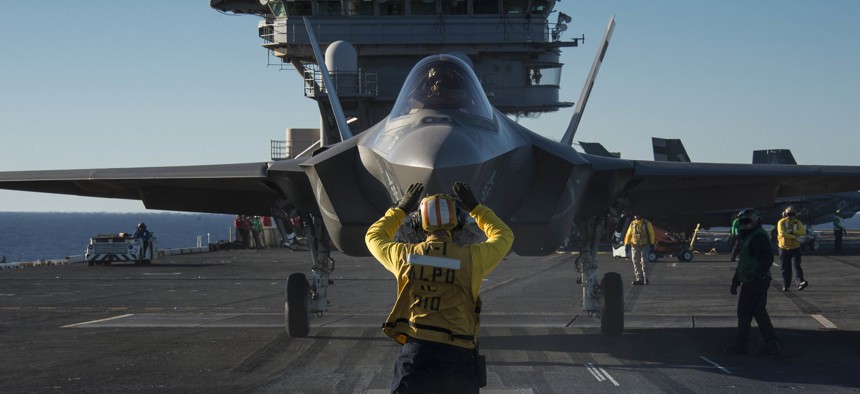
An F-35C Lightning II is prepared for launch aboard the aircraft carrier USS Nimitz (CVN 68) in the Pacific Ocean, Nov. 4, 2014. Mass Communication Specialist 1st Class Brett Cote/Released
Esper's Convenient Lie
The defense secretary's claim that the two decades of countering violent extremism left the U.S. under-prepared for a near-peer fight doesn’t hold water.
In a Wednesday speech about readying the U.S. military for war with China or Russia, Defense Secretary Mark Esper said, “For nearly two decades the United States concentrated on violent extremist organizations in low intensity conflicts that left us less focused and prepared for a high-end fight against near peer adversaries.”
This is a convenient lie the Pentagon has told itself to excuse two decades of investing in legacy, wasting assets. It's embarrassing to see the secretary of defense repeat it.
The United States sent a lot of servicemembers to fight in Iraq and Afghanistan and spent a whole heck of a lot of money in those wars. But the rising tide of defense spending after 9/11 lifted all boats, including more money for things that had nothing to do with the wars. The causes of the Defense Department’s current lack of preparedness for China and Russia are many, but blaming the wars in Iraq and Afghanistan lets the department off the hook for its own dysfunctions. While U.S. troops were fighting in Iraq and Afghanistan, the Pentagon was steadily investing billions to deter and fight big wars against the nation-state adversaries to which Esper refers — just not in the right way.
Esper’s claim that the two decades of countering violent extremism left the U.S. under-prepared for a near-peer fight doesn’t hold water. The Defense Department has spent billions on modernization programs aimed at countering nation-state threats.
The largest defense weapons program during the last two decades, by far, is the F-35 Joint Strike Fighter, an aircraft that is certainly not optimized for counterterrorism or counterinsurgency. The F-35 program is estimated to cost nearly $400 billion in research, development, and procurement, with lifetime operating and sustainment costs estimated at over $1 trillion dollars. Other big-ticket defense modernization items over the past two decades include the $13 billion apiece Ford-class aircraft carrier which, again, is not a platform one invests in if designing a military for countering violent extremists.
Other modernization projects collapsed of their own accord, doomed by acquisition mismanagement and overly ambitious requirements. The Army squandered roughly $18 billion on Future Combat Systems attempting to network its battlefield, with little to show for it. The Navy spent a whopping $22 billion on the DDG-1000 Zumwalt stealth destroyer program to produce only three ships.
In reality, Defense Secretary Bob Gates struggled to focus the Pentagon’s force development priorities on the wars in Iraq and Afghanistan. Gates criticized the department’s tendency towards “Next-War-itis,” to focus on the future big wars against nation-state adversaries like Russia and China at the expense of the ongoing wars.
Instances where modernization programs against nation-state threats were put on the chopping block to free up funding for the wars, like Gates’ decision to curtail production of the air-to-air F-22 stealth fighter, were notable precisely because they were rare. Even in those cases, though, the counterfactual claim that the Defense Department would have been more ready for China and Russia were it not for the wars in Iraq and Afghanistan doesn’t hold water. From 2001 to 2008, the non-war base budgets of the Navy and Air Force grew 22 percent and 27 percent, respectively, when adjusted for inflation. Prior to 9/11, the Defense Department budget was growing at only 2.5 percent annually. Were it not for 9/11, and the counterterrorism wars that followed, the Air Force would have faced a far more difficult budget environment in 2009, when the F-22 was curtailed. If anything, the wars in Iraq and Afghanistan allowed overpriced, baroque weapon systems for future wars to hang on longer than they normally would have, carried along by the swell of defense spending.
If we don't get to the root causes of why the Defense Department has failed to adapt to the suite of anti-access capabilities that defense analysts have seen coming for 15 years, and why the Pentagon remains over-invested in legacy, wasting assets, then the U.S. military never be able to respond to the China threat.
The reality is that the United States has a military that is not optimized for power projection into contested environments against a near-peer competitor, nor is the U.S. military optimized for countering violent extremism (which would look radically different). The United States has a military optimized for re-fighting the 1991 Persian Gulf War. Why? Because it's comfortable. It's comfortable with defense contractors, Congress, entrenched bureaucratic interests in the Pentagon, and even many senior military leaders.
Esper is right that “sequestration, continuing resolutions, and insufficient budgets, prior to 2017” all have harmed the Defense Department’s bottom line, and that the Department has seen “a great deal of funding” since Donald Trump came to office.
But to actually adapt to the challenges the U.S. military faces, the Defense Department needs more than just more money. The U.S. military needs to start changing how it fights. That's uncomfortable. The U.S. defense community loves fixating on widgets, whether it is hypersonics, directed energy, artificial intelligence, or other techno-solutions. The military service branches are the worst at this. They fixate on numbers, even though those are precisely the wrong metrics. The Navy wants 355 ships. The Air Force wants 386 operational squadrons. The Army wants 500,000 soldiers. Those are the wrong metrics for a 21st century fight.
It is far more important what is on those ships and planes and ground vehicles, how they are networked together, how they fuse and share data, how units manage command-and-control in contested electromagnetic environments, and how they employ intelligent networked munitions. Many more generals and admirals seem to say this than the politicians who boast about funding them. Across the military, leaders are experimenting, prototyping, and developing new ways to operate in contested environments with the money they have. The problem is that when the rubber meets the road in spending, innovation runs into a brick wall. Congress and the Pentagon keep spending too much on the same outdated hardware.
Consider that the bulk of U.S. power projection is in short-range fighter aircraft that will struggle just to make it to a near-peer fight. The Navy is building $13 billion aircraft carriers with aircraft that don’t have the legs to get to the fight during the critical early window when military planners are worried about a “fait accompli” by adversaries. Why? Because it would have been uncomfortable for the naval aviation community to invest in an uninhabited combat aircraft that actually had the range to show up in a contested environment. It isn’t because the United States was too fixated on the wars in Iraq and Afghanistan. The 2006 Quadrennial Defense Review called for the development of such an aircraft, yet the naval aviation community strangled it in its crib, scoping down the requirements to a plodding tanker. The Air Force has known for at least over a decade that in a fight with China, airbases in the first island chain would be hammered by Chinese missiles and the current inventory of short-range fighters would struggle to project power from the second island chain. Yet the Air Force remains dominated by short-range fighters rather than long-range stealthy crewed and uninhabited aircraft that can project power and persist in contested areas.
Blaming the wars in Iraq and Afghanistan passes the buck. There are plenty of reasons why the United States hasn't adapted its forces to a rising China, but a lack of money isn't one of them.
Paul Scharre is a senior fellow and director of the technology and national security program at the Center for a New American Security, or CNAS. He is the award-winning author of Army of None: Autonomous Weapons and the Future of War.
NEXT STORY: The Air Force Needs a New Non-Stealthy Bomber




